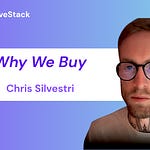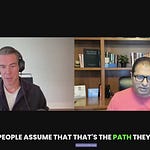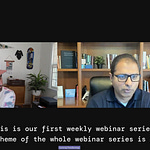Listen now on Apple, Spotify, Overcast, Google and YouTube.
In this episode, we're joined by Chetan Rawal to dissect the intricate process of integrating Product-Led Growth (PLG) strategies atop existing Sales-Led Growth (SLG) frameworks.
Chetan shares his perspective on why and how these two approaches should be managed by distinct teams and leadership within an organization. For further insight, don't miss Chetan's recent post, "Common Myth Amongst Sales-led Orgs: Stagnating Growth?", which explores some of the misconceptions surrounding SLG.
He dissects the idea that while PLG and SLG might initially compete, they eventually find synergy. He advocates for the establishment of PLG teams that operate with the agility and innovative spirit of a startup, emphasizing the need for rapid iterations and a focus on product evolution
.
Here's What's in Store for You:
[0:42] Chetan introduces the primary challenges of transitioning from SLG to PLG.
[6:36] Analysis of which teams struggle the most with the adoption of PLG.
[9:09] Chetan's perspective on how deal sizes and sales structures influence the move to PLG.
[11:04] Exploring the role of Customer Success Managers (CSMs) and designers in PLG.
[12:20] Understanding the difference between good and bad tech debt in PLG.
[13:36] How practically every department grapples with the shift to PLG.
[16:45] Strategies for hiring and positioning for PLG readiness.
[18:38] The significance of generalists in the initial phases of PLG adoption.
[19:19] Necessary changes in monetization models for a PLG approach.
[23:38] Case studies of companies transitioning from SLG to PLG.
Identifying the Challenges
Leadership Influence
Accepting New Principles: The switch to PLG requires leaders to evolve from a sales-first mindset to one that places the product and user at the forefront. It's about embracing a philosophy where product quality and user satisfaction drive growth.
Instilling a PLG Mindset: Founders and executives must champion this shift, promoting a culture that values product innovation and customer experience as the new engines of revenue and expansion.
Resource Allocation
Funding the Transition: Redirecting the financial stream is pivotal. It involves moving the budget away from traditional sales departments to areas essential for PLG such as product development, user interface enhancement, and customer support.
Securing Commitment: A major part of this transition is convincing stakeholders of PLG's long-term benefits. Detailed projections and success stories from PLG approaches can help underline the potential for sustained growth and profitability.
Departmental Challenges
Engineering: Building for the User
User-Centric Development: Engineers are tasked with shifting their focus from feature-heavy releases to building functionalities that directly address user needs, enhancing the user experience.
Iterative Feedback Loop: Incorporating user feedback into the development cycle becomes paramount, demanding more agile and responsive engineering practices.
Product Management: Steering the Vision
Data-Driven Decisions: Product managers must utilize product usage data to inform the roadmap, ensuring that enhancements are aligned with user behavior and preferences.
Cross-Department Collaboration: They need to facilitate collaboration between departments, making sure that product developments are in sync with marketing, sales, and customer service initiatives.
Marketing: Communicating Value
Educating Users: Marketers need to pivot from broad messaging to educating potential users on the product's value, utilizing insights from user data to tailor communication strategies.
Driving Adoption: The goal shifts from lead generation to driving product adoption and user retention, emphasizing the product's practical benefits and user success stories.
Sales: Adapting to a Consultative Role
Guiding, Not Selling: Sales teams adapt to a more consultative role, helping prospective users understand how the product can solve specific problems rather than pushing for a hard sell.
Leveraging Usage Data: Utilizing product usage data to identify upsell and cross-sell opportunities, providing tailored solutions based on how customers are using the product.
The Role of Analytics
Informed Strategic Moves: Across all departments, the analysis of product usage data is not just a task—it's the cornerstone of strategic decision-making, providing insights into user engagement, feature popularity, and the overall health of the product.
The PLG Implementation Checklist
Case Studies of Transition
Adobe and Figma
Approach: Adobe's acquisition of Figma showcased a strategic shift towards PLG.
Focus: Emphasizing user-centric design tools and collaborative features.
Outcome: Enhanced market position in the design space with a broader, more engaged user base.
Microsoft and OpenAI
Collaboration: Microsoft's partnership with OpenAI represents a significant move into AI-driven PLG.
Integration: Leveraging OpenAI's capabilities to enhance Microsoft's product offerings.
Impact: This partnership has not only expanded Microsoft's technological frontier but also attracted a diverse new user demographic.
Learning from Upwork's Strategic Growth Approach
Conscious Hiring for Growth
Upwork, known for its Product-Led Growth (PLG) alongside an enterprise Sales-Led Growth (SLG) approach, made a strategic move to develop its Growth team. Initially, they focused on hiring generalists. These versatile team members were not only adept at identifying key growth levers but also skilled in implementing strategies to leverage them. This approach allowed the Growth team to gain trust within a company that was initially hesitant about expanding beyond its original five-person investment.
Transition to Specialization
As the Growth team proved successful in launching new products, Upwork's hiring strategy evolved. They began recruiting specialists to sustain and build upon the growth foundations laid by the generalists. This shift in focus ensured continued development and expansion in subsequent growth phases.
Strategic Recommendations for Managing PLG and SLG
Establishing Independent Teams
Distinct Functions: Initially set up PLG and SLG teams with separate goals and strategies. This allows each team to focus on their strengths without interference, much like specialized units within a larger army, each with a specific mission.
Cultivating Expertise: Encourage each team to develop deep expertise in their respective domains. For PLG, this means a strong focus on product development and user experience, while SLG teams concentrate on customer relationships and market expansion.
Integration Over Time
Gradual Synergy: Over time, these independent teams should start to find points of synergy. It's like two different musical instruments playing their tunes and slowly harmonizing into a cohesive melody.
Cross-Functional Collaboration: Encourage regular cross-team collaborations and meetings to share insights and strategies. This can lead to innovative approaches where PLG insights inform SLG strategies and vice versa.
Leadership and Vision
Guiding the Harmony: Leadership plays a crucial role in guiding this process. They should act as the conductors, ensuring that both teams are in tune and working towards the overarching objectives of the company.
Long-Term Strategic Planning: Incorporate both PLG and SLG perspectives in long-term planning, ensuring that decisions are made with a holistic view of growth, customer engagement, and market dynamics.
Measuring Success
Balanced Metrics: Develop metrics that measure the success of both PLG and SLG strategies. This ensures a balanced view of performance and helps in making informed decisions about resource allocation and strategy adjustments.
Conclusion
In closing, effectively merging Product-Led Growth (PLG) with Sales-Led Growth (SLG) is about finding the right balance. It starts with setting up separate teams focused on their specific strengths and then gradually bringing them together to work as one. Led by clear and focused leadership and evaluated through well-defined metrics, this strategy can open new opportunities for innovation, improve customer relationships, and drive market expansion.
Learning from other companies' experiences and following these strategic steps, businesses can smoothly transition to this combined approach, laying a solid foundation for continuous growth in the B2B SaaS sector.
Where to Find the Guest:
LinkedIn: Chetan Rawal
Where to Find the Host:
LinkedIn: Gururaj Pandurangi
Resources:


















